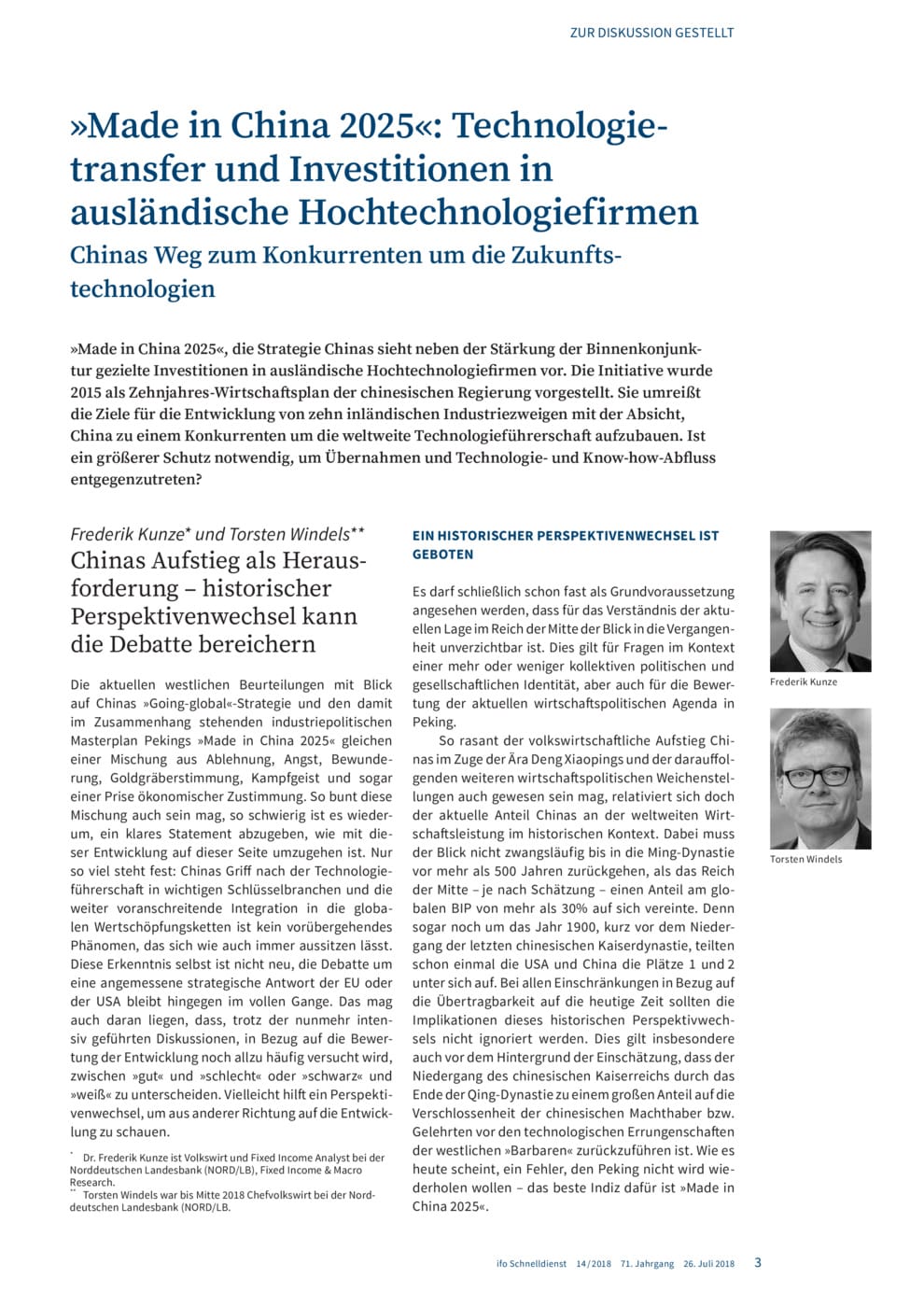“Made in China 2025”: Technology Transfer and Investments in Foreign Hi-Tech Firms – China En Route to Becoming into a Competitor in Future Technologies
ifo Institut, München, 2018
ifo Schnelldienst, 2018, 71, Nr. 14, 03-20

In addition to boosting its domestic economy, China’s “Made in China 2025” strategy provides for targeted investments in foreign hi-tech firms and outlines development goals for ten domestic industry branches with a view to consolidating China’s position as a competitor for leadership of the global technology industry. Is greater protection required to combat takeovers and a technology and know-how drain? For Frederik Kunze and Torsten Windels, Norddeutsche Landesbank (NORD/LB), it is clear that China’s bid for the technological lead in key branches and its progressive integration in the global value chain is no temporary phenomenon. Having successfully accumulated trade surpluses, the country is no longer passively waiting for technology transfer via direct investment, but is buying-in technology in a targeted manner. The general advantages of open markets and the opportunities that arise through working with an investor from China have been extensively documented. Citing the rules of fair competition, however, is not the right way to approach a strategic and dominant player like China; reciprocity must be demanded instead. According to Max J. Zenglein and Anna Holzmann, MERICS, China would like to be one of, if not the leading global power among the industrialised nations by 2049. “Made in China 2025” formulates the goal of advancing the country in ten key industries. While China has every right to develop its own economy, however, Chinese and foreign players must be able to compete fairly. That is why companies and governments should not lose sight of the Chinese innovation initiative and must proactively support framework conditions that leave them with room for manoeuver. Horst Löchel, Frankfurt School of Finance & Management, sees “Made in China 2025” as a major opportunity for Western companies. In order to deploy cutting edge technologies, China first needs to acquire them. This opens up sales opportunities for European and German manufacturing and may potentially lead to the creation of new industrial European and Chinese conglomerates and joint ventures. Moreover, Chinese direct investment in Europe and Germany can be deemed positive in every respect, since it brings fresh capital for companies and often creates greater business opportunities in China. On the other hand, it is also right to insist on reciprocity with China. Ultimately, however, it is positive that “Made in China 2025” is intensifying competition. Antonia Reinecke and Hans-Jörg Schmerer, Open University of Hagen, see initial successes in China’s strategy of becoming more active in high-tech industries, partly via the acquisition of high-performance technologies from abroad. It is currently impossible to say whether China will succeed in driving technological change and taking over a leading position in technology internationally by pursuing this path. It is, however, clear that China is investing heavily in technological progress and is attempting, both nationally and internationally, to close the gaps with industrialised nations. Oliver Emons, Hans-Böckler-Stiftung, raises the question of the extent to which China is a partner or a rival and reviews the different perspectives on and experiences with Chinese investors. In his opinion, there were various reasons for takeovers in recent years. Although individual takeovers seem to have been largely positive to date, top managers in the companies that have been taken over view these investments very sceptically and with great uncertainty. It remains to be seen whether Chinese company buyers will take their commitments seriously in the long term, or merely view them as a legal formality. Markus Taube, University of Duisburg-Essen, firmly believes that China will be highly successful in the global battle for future technologies in the years ahead. For foreign players interaction with China is increasingly becoming like balancing on a knife’s edge. Key stimuli and resources for acquiring knowledge and developing technology in China have come from abroad. In the longer term there is a danger of being driven out of the market by Chinese players, who may be able to assemble significant competitive power in global markets thanks to a combination of the foreign expertise that they have absorbed, state protection and subsidies, as well as their own smart entrepreneurship. In the years ahead German companies need to exploit prosperity-boosting opportunities to interact with the Chinese economy and its companies as intensively as possible and neutralise the Chinese state’s role in distorting competition as far as possible.